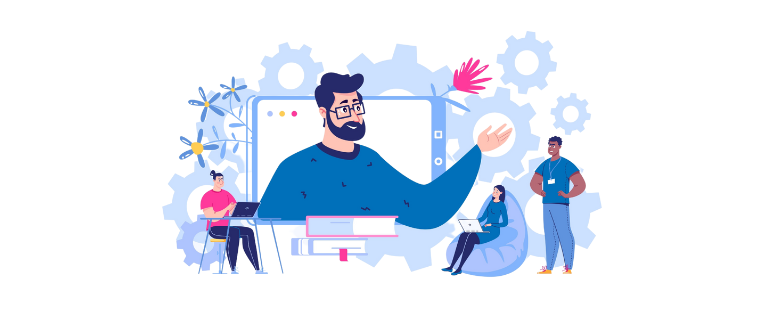
How to Deliver Inclusive and Accessible eLearning Through Your LMS
In today’s rapidly evolving educational landscape, ensuring that learning experiences are inclusive and accessible to all is more important than ever. As educational institutions and businesses alike increasingly rely on digital platforms, a Learning Management System (LMS) can play a pivotal role in democratizing education and employee training opportunities. However, achieving true inclusivity extends beyond simply providing online access; it requires thoughtful integration of tools and strategies that address diverse needs. In this blog, we will explore how to leverage your LMS to deliver content that is accessible to learners with varying abilities and backgrounds, fostering an environment where everyone has the opportunity to succeed. From implementing adaptive learning paths to ensuring content meets accessibility standards, this guide will equip you with practical steps to create a truly inclusive digital learning experience.
Understanding Inclusivity and Accessibility
Before diving into the specifics of leveraging your LMS for inclusive and accessible learning, it’s essential to distinguish between these two concepts. Inclusivity in education refers to creating a learning environment that values and supports diverse learners, allowing them to thrive regardless of their background, ability, or learning style. Accessibility, on the other hand, focuses on removing barriers that may prevent learners with disabilities from fully engaging with educational content. By prioritizing both inclusivity and accessibility, educators and organizations can ensure that all learners have equitable opportunities to learn and succeed.
Key Practices for Delivering Inclusive eLearning
1. Leverage Universal Design for Learning (UDL) Principles
Universal Design for Learning is a framework that aims to optimize teaching and learning for all individuals by providing multiple means of engagement, representation, and action and expression. By integrating UDL principles into your LMS, you can create a flexible and supportive learning environment. This might include offering multiple formats for content delivery, such as videos, podcasts, and text, and providing options for learners to demonstrate their understanding in various ways. For example, allowing learners to submit either a written report or a video presentation caters to different strengths and preferences, thereby enhancing the learning experience.
2. Implement Responsive Design
Responsive design ensures that your LMS is accessible across different devices, including smartphones, tablets, and desktops. Given the variety of devices learners may use to access content, it is crucial to design your learning materials to adapt seamlessly, maintaining functionality and readability across platforms. This flexibility helps accommodate learners who rely on specific devices due to disabilities or personal preferences. Moreover, as mobile learning becomes increasingly prevalent, ensuring your LMS is mobile-friendly can significantly improve engagement and participation.
3. Diversify Learning Materials
Inclusivity can be enhanced by diversifying the types of learning materials provided. This might involve incorporating multimedia resources, such as infographics, simulations, and interactive modules, that cater to different learning styles. By combining these elements with traditional text-based materials, you ensure that visual, auditory, and kinesthetic learners all have access to resources that resonate with them. Additionally, offering culturally diverse materials can provide a broader perspective, enriching the learning experience for everyone.
Ensuring Accessibility in Your LMS
1. Adhere to Web Content Accessibility Guidelines (WCAG)
The Web Content Accessibility Guidelines (WCAG) set forth recommendations for making web content more accessible for people with disabilities. Ensuring your LMS content meets WCAG standards is fundamental to creating an accessible learning environment. This includes using semantic HTML, providing alt text for images, ensuring sufficient color contrast, and making your content navigable via keyboard.
2. Use Accessible Multimedia
While multimedia can enhance engagement, it’s crucial to ensure that these elements are accessible. Provide transcripts for audio content and captions for videos, enabling learners with auditory impairments to access the information. Additionally, consider offering sign language interpretation for key video content when possible. When designing interactive content, ensure compatibility with screen readers and other assistive technologies, making certain that all learners can fully benefit from these resources.
3. Offer Alternative Assessments
Standard assessments can present challenges for some learners, particularly those with disabilities. To address this, consider offering alternative assessment methods that allow learners to demonstrate their mastery of the material. This may include oral presentations, projects, or interactive demonstrations, all tailored to meet diverse needs effectively. Furthermore, providing flexible deadlines and multiple attempts where feasible can also accommodate different pacing needs, reducing anxiety and fostering a more inclusive assessment environment.
4. Training Instructors and Staff
Creating an inclusive and accessible learning environment requires not only technological adjustments but also a commitment from educators and staff. Training instructors on the importance of inclusivity and the practical steps they can take to support diverse learners is crucial. Workshops and ongoing professional development can equip them with the skills and confidence needed to utilize the LMS effectively, ensuring it remains a tool for empowerment and growth.
5. Fostering a Culture of Inclusivity
Ultimately, the success of inclusive and accessible learning through your LMS depends on fostering a culture that values diversity and proactively identifies and removes barriers to learning. Involve learners in the feedback process, encouraging them to share their experiences and insights. Regularly update and refine your LMS offerings based on this feedback, and stay informed about emerging accessibility standards and technologies. By championing a commitment to continuous improvement and open communication, you can create a dynamic and supportive learning community.
By committing to inclusivity and accessibility, you can transform your LMS into a powerful tool that empowers all learners, equipping them with the skills and knowledge they need to succeed in an ever-changing world. As organizations and educators continue to adapt in response to technological advances and societal shifts, ensuring that learning is accessible and inclusive is not just a best practice but a fundamental responsibility.

.svg)









Leave a Reply